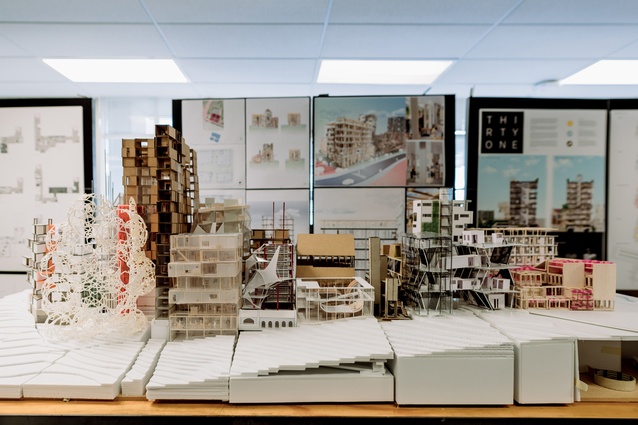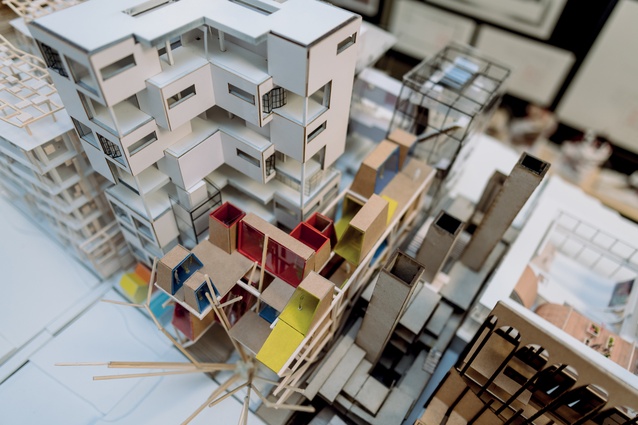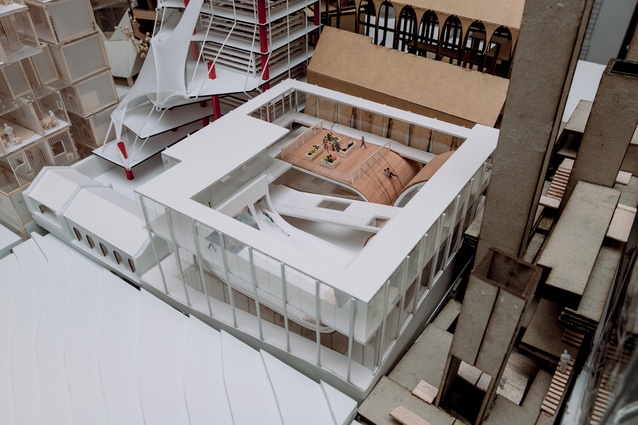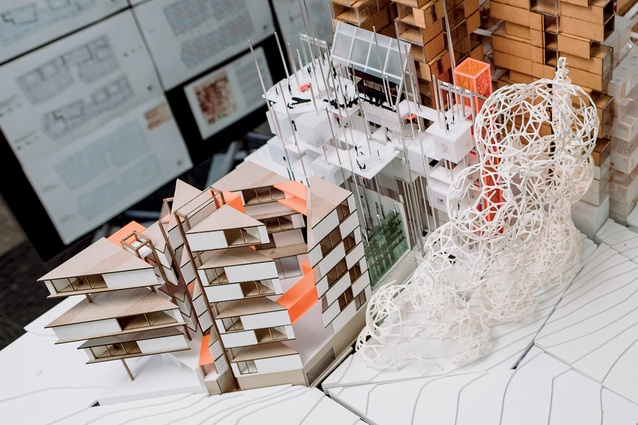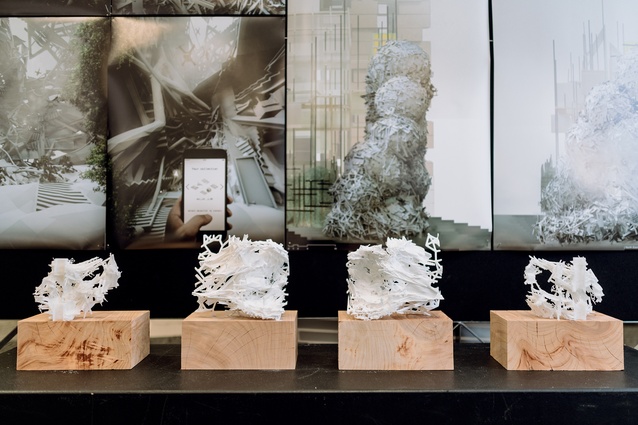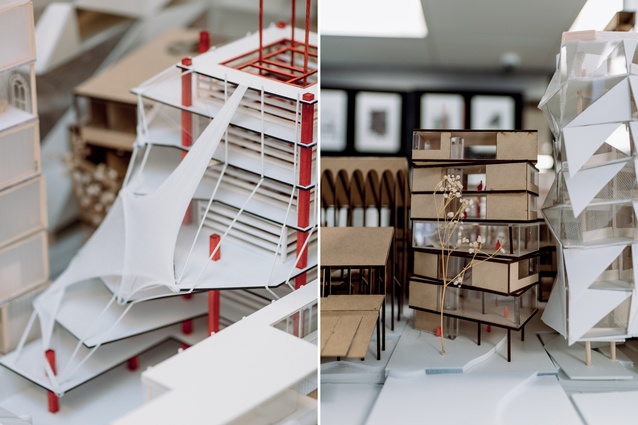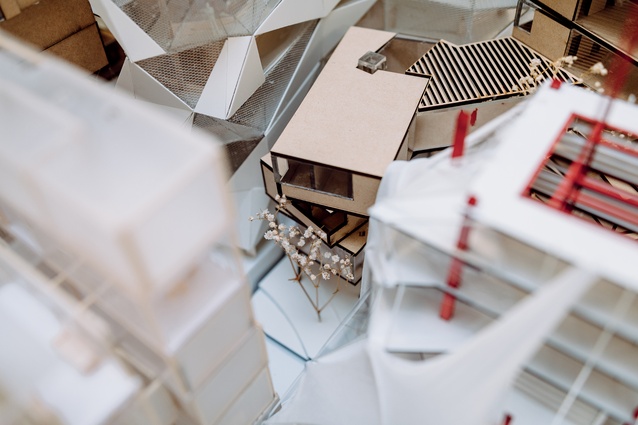Ch-ch-ch-ch-changes
When is architecture finished? That is the key question being asked within an advanced design course run at the University of Auckland by professional teaching fellow Chris Barton and architect Jeremy Smith, who are interviewed here by Justine Harvey.
First-year master of Architecture students (fourth year) in the School of Architecture and Planning are being asked to examine how a building inhabits an environment that is constantly undergoing changes in a variety of ways.
In the urban environment, architecture is routinely finished and static in the face of ongoing changes, such as population growth, new city plans, affordability and climatic variations. Barton and Smith suggest that landscape urbanists “hold all the cards”, making regular change in the spaces between buildings, while the buildings themselves wait far longer for their opportunities.
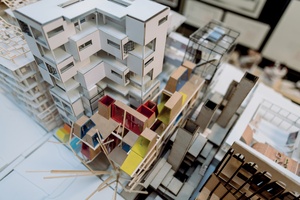
With this in mind, two years ago, the pair set up their ‘Ch-ch-ch-ch-changesʼ teaching studio to advance the proposition that architecture is not about a finished building in an inevitably changing environment but about designing for a continual dialogue between the building and its context.
The course invites students to adopt the design practices of Irving Smith Architects, which views architecture as not about ‘finishingʼ but as an iterative process in an ongoing dynamic, rather than a fixed, context. Over the 12-week period of the course, the students have to produce six hand-ins, including producing six models and presenting them in front of their tutors and peers, culminating in final presentations to external architects and critics.
Justine Harvey (JH): How do the studios work?
Chris Barton (CB): I run my studios with a practising architect and the underlying premise is that this is an opportunity to adopt the design practice of that particular firm. So, it’s actually trying to tease out what they do and break that down into steps that you can take the students through.
The great thing about working with Jeremy (Smith) is he was already thinking about what his design practice was, because he was engaged with his PhD at the university. We were so much further ahead in terms of understanding what it was that Jeremy did when he was designing. So, it was trying to turn his tacit knowledge into something to transfer to the students.
JH: Do you think that it’s an instinctive thing with a lot of architects: that they don’t have the time to stop and analyse their practices?
CB: But they should.
Jeremy Smith (JS): And we do. The big difference between university and practice is that you don’t just start and hand something in after 12 weeks. Life’s just not like that. It’s continual. The first thing we did, rather than having one hand-in after 12 weeks, was to make every second week a hand-in.
So, rather than spending time circling and circling, thinking about what you’re going to make, we bring the deadlines forward, as if you’ve got a client coming in on Tuesday. So you actively have to make and, because everyone’s sites are joined together, it’s quite communal. It’s independent but, if you don’t do your work, you’ve actually let everyone else down as well. It’s really obvious if you’re not changing and everyone else is.

CB: When we wrote a paper for last year’s Annual Design Research Conference in Sydney, we tried to figure out what made the teaching really different and that was a key thing: that idea of a joined-up site and everyone doing their own thing on the site.
JS: Yeah, because that becomes less competitive. So, you’re not all going, “Oh my God, your museum is better than my museum”. There’s also a variance in dynamic going on because you have to make a model. So, they’re all talking but, if your neighbour does something, you’re going to have to respond.
JH: And that happens all the time in practices, doesn’t it? Where some stakeholder comes in and says, “This is going to happen, so you can’t do that now”.
CB: We’d talked a lot about Jeremy’s thesis and this idea of architecture never being finished but, when it comes down to it when running these studios, the question is “what is it you do?” Jeremy’s answer to that was really different because he said, “We just have a table in the middle of the room in our office and we’re constantly making models and putting them on that table”.
The idea of the central table, where everyone was doing stuff and putting it on display and having it critiqued, became a key feature of the studio. So, that was an example of being able to say, “Well, this is how Irving Smith does it; have a go! Just see what it’s like by doing it with models.”
What emerged from that was that it wasn’t just about model-making; there was a whole drawing practice that came out of model-making as well. This is the method that Jeremy’s practice uses where they photograph the models, exterior and interior, and, instead of doing renders, they’re actually using the photographs that are then photoshopped to provide their perspective views.
JS: What was good about the programme was that, if they set it up and did it rigorously throughout the project, they didn’t have a massive 12 weeks’ worth of work to do and hand in at the end. And that’s what practice is like because, in practice, you can’t have massive highs or you’ll spend all your time doing something, which then just falls off.
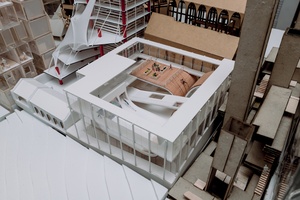
CB: The crit plays an essential part in all architecture studios. Our crits were ongoing. And you could argue that many studios are like that. Every time someone put stuff up, there was this period where they knew they were going to get a crit, and the crit would be, “Okay, how is this going to be improved?” And this is when Jeremy would come along and say, “Hmm, what if we do this?” And he’d pick a piece, actually breaking the model, which was pretty horrifying for the students the first few times. So, there was this constant “What if?” question being asked – but it was physical. Sometimes he’d cover parts of a building.
JS: The benefit of doing it every two weeks is that it’s iterative so it doesn’t matter. You haven’t just worked for 12 weeks, including a week without sleep, making this model when they turn up and rip a bit off, and you can’t respond! You’re now being asked to change it. That might be something to think about.
JH: Well, the creative process is organic.
JS: Yes. Everyone’s looking at everyone else for reasons to change, for prompts; they actually all have to be involved in the crit.
CB: You have to know what is going on around you, because those adjacent sites became very important to what you are doing next.
JS: The students actually became quite good at critiquing themselves. The further into it we went, the more we asked them to comment for other people. The further into it we went, the more barriers were broken down and they gained more confidence in arguing back to us – and to each other.
JH: That’s a great skill to have because, when you gain a lot of experience in something, you become quite self-critical – in a positive way.
JS: As a practising design studio employing young graduate architects, you want a design training. We want people who will politely argue back: “No, I’ve done this for this reason. This is why it’s important.” That’s what you want.
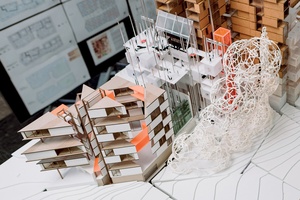
CB: What was going on with those regular crits, which was different, was a dialogue between Jeremy and myself. He would say things like: “Use your design eye”. And these were big signals for me because that’s the tacit, hidden knowledge of what he does. I would challenge him: “What do you mean by that?” And Jeremy would talk more about it and the student would engage, and it became this three-way tension of trying to draw out what it was that Jeremy was trying to communicate through his critique of the design. Then, how you could pass that on to the students. It would go back and forth.
JH: What did you learn from the first time you ran the course that you could apply to the second? Did you change the changes you gave the students?
JS: No. The first time we had the idea, we knew what kind of changes we would make, we just didn’t know which order they would take. But, it actually became quite clear.
CB: They could design anything they wanted to start off with. And the first change was, “Okay, how are you modifying it in response to everyone around you?” And then the next change was, “Okay, now your building has been bought by someone else and they want to change the use”. Then, we had the big earthquake/fire, and all the heritage buildings were gone so they suddenly ended up with a larger site. And then, it was about what they did with that site, and whether they respected or ignored the heritage that had been taken.
Then we said, “Yep, we love what you’ve done but we need 25 per cent more floor area.” So, in many ways, it’s really explicit that this one design is being improved all the way through, and you could see various moments when students realised that they had made something so much better than what they had started out with.
JH: Did some of the students come up with things that made you think, “I wish I’d thought of that”?
JS: Yeah, that happens every time! I commuted from Nelson to run the course in Auckland and I’d sit on the plane going back each night just full of ideas. It’s so good for your brain.
CB: In the latest group, we had this student, Jack, who went into this whole different direction with virtual reality. I didn’t think something like that was possible within the parameters of the studio but it just showed that you could pretty much do anything. Because the one thing I’d thought about was whether or not Jeremy’s modelling process, which tends to be card models, created a certain type of architecture. But you could see in Jack’s work that that constraint wasn’t there. It was in many of the others but we started getting some pretty interesting forms that were not limited by the materials of the model-making.
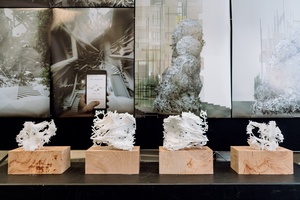
JS: A couple of times we’ve had students that’ve been nervous about really pushing a design. In these cases, we’d say, “Just do it! If it’s a disaster and you hate it, we’ll support you
the next week in taking it down again.”
JH: It must be hard for some of the younger students to have confidence in their creativity at that age. This type of programme must help with that.
JS: That’s the greatest reward I’ve had from it, in both years. Having students gaining confidence and finding ways that suit them to work, including trialling different things, and keeping on going with them.
JH: Are there things you’d change for next year?
CB: Well (Prof.) Andrew Barrie’s view is that you don’t get a studio right until you’ve done it three times. We’ve done it twice so we’ll go for another one. There’s no point in doing it unless you really think you’re improving and refining. So, we’ll continue to refine.
JS: We have to stay light on our feet – making change.
This article first appeared in Architecture New Zealand magazine.


